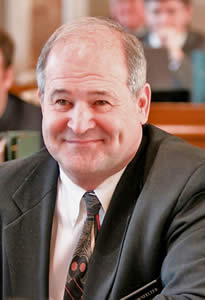‘Overly aggressive’ estimates put KEES over budget, auditor tells legislators
by Megan Hart, KHI News Service
A new computer system for enrolling Kansans in Medicaid and other public assistance programs will generate far less than the expected $300 million in savings, a Legislative Post Audit report found.
The Kansas Eligibility Enforcement System (KEES) was intended to be a central portal where people could apply for benefits like Medicaid, food stamps and cash assistance, and the state could automatically verify their eligibility.
The Kansas Department of Health and Environment and Kansas Department for Children and Families estimated that the new system would generate $300 million in savings over 10 years. But costs have exceeded what was planned and the assumptions behind the savings calculations were flawed, according to the report.
The state originally estimated it would cost about $188 million to build KEES and maintain it through August 2016. However, if current trends continue, the cost through August will be closer to $234 million — about 25 percent above the estimate — mostly due to increased expenses to build the site.
Estimates of savings were “overly aggressive,” Matt Etzel, who led the Post Audit team, told the House Social Services Budget Committee last week.
KDHE and DCF had estimated the system would save them $134 million in federal penalties, despite the fact that the state had only paid one penalty — of $300,000 — in recent years. Federal officials levied the penalty because Kansas didn’t meet a subgroup work program requirement in fiscal year 2012 related to Temporary Assistance for Needy Families.
The agencies also likely overestimated their savings on postage, the report said. They predicted their combined annual postage and printing budget would fall from $3.1 million to $500,000, for a savings of $26 million over 10 years, according to the audit.
It also isn’t clear how much of the other projected savings will materialize, as the audit summary notes. The two agencies predicted about $21 million in savings from reduced staff time related to applications and $51 million from catching fraudulent applications. The audit anticipated some benefits from those factors but couldn’t quantify how much they might be.
The only clearly defined savings the audit found was $10 million spread over 10 years that the state avoided by not maintaining older systems that KEES will replace.
More hands-on work required
So far, the system can only automatically verify information for about 10 percent of applicants, Etzel said, requiring more hands-on work than anticipated. The state hasn’t set a firm deadline to fix those issues, he said. The system also isn’t working as expected when it comes to sending some automated notices to applicants, according to the audit.
Some less-important features also were delayed or removed. KEES won’t have a consolidated customer service center, as planned. A feature that would allow people to check the status of their applications remains in the plan but doesn’t have a deadline for completion.
The system was supposed to be largely online by December 2013, Etzel said, with final touches added by May 2014. That deadline wasn’t realistic, he said, and the portal for medical programs like Medicaid wasn’t up and running until July 2015.
The costly delays prompted a legislative committee last year to approve the audit of KEES.
A second portal for other social services programs isn’t expected to be ready until August, which would put it more than two years behind schedule, Etzel said.
“This delay causes the state to rely on less efficient legacy systems,” he said.
‘Plenty of blame to go around’
The audit said poor communication between the state and contractor Accenture contributed to the delays. Frequent federal and state policy changes also were significant factors, Etzel said.
Glen Yancey, chief information officer with KDHE, said federal mandates, many of them due to health care reform, were the largest cause of changes to KEES, and state policies caused 15 percent to 20 percent of changes.
For example, the federal Centers for Medicare and Medicaid Services advised them to separate medical programs from other social services due to the complex changes happening in health insurance, he said.
“Almost 50 percent of the changes that had to be made were federal mandates,” he said. “In the IT world, we equate it to trying to change the wheels on a bus as it’s moving down the highway.”
It isn’t clear when the work will be finished, Yancey said, though he said he expects to have a better estimate in the next three months. Contracts have been changed so that Accenture will have to deliver certain products by deadlines to get paid, he said.
Rep. Will Carpenter, an El Dorado Republican who was among the legislators who called for the audit, urged the committee to focus on moving forward.
“There’s plenty of blame to go around, but that isn’t going to solve one thing,” he said.
When Yancey said mistakes were made and those involved with KEES are learning from them, Carpenter responded: “I think that’s what I wanted you to say. There were mistakes made, and it wasn’t just the federal government.”
Yancey also asked legislators to keep the complexity of building such a system in mind. Similar projects “imploded” in three other states, he said.
“They want to know what we did to get ours right and to get it live,” he said. These projects “are more prone to failure than they are to success.”
The nonprofit KHI News Service is an editorially independent initiative of the Kansas Health Institute and a partner in the Heartland Health Monitor reporting collaboration. All stories and photos may be republished at no cost with proper attribution and a link back to KHI.org when a story is reposted online.

